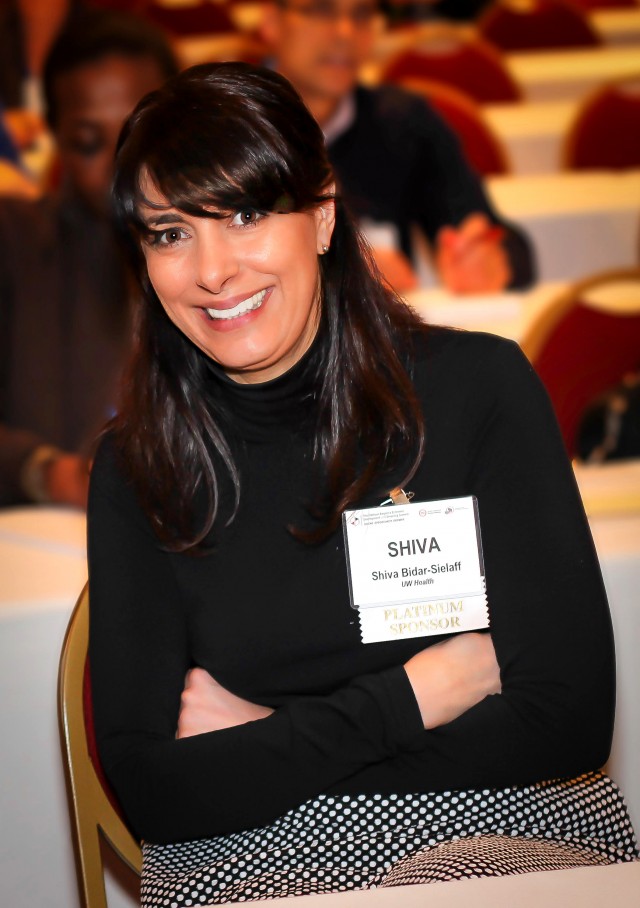Shiva Bidar is a long-time Madison City Council veteran who represents her west-side district that includes much of the UW-Madison campus and the Regent neighborhood.
Born in Iran, Bidar moved to Spain as a child where she grew up attending French schools. 1n 1997, she started working at UW Health, an integrated health system serving 618,000 patients each year in Wisconsin, Northern Illinois, and beyond with 1,400 physicians, six hospitals, and 80 outpatient sites. Bidar now serves as director of community partnerships at UW Health.
Bidar is very active in the community, especially Madison’s growing Latino community. She is nationally recognized for her work in the area of diversity and inclusion and has been a frequent speaker at national conferences on cultural competence and health care interpreting.
We caught up with her recently to ask her our 12 questions.
1. Rank your Top 5 MCs. Tupac, Run DMC, LL Cool J, Common, Jay Z. Also, why are you not asking what music we like to listen to? Because, in addition to the MCs I listed, I am going to say The Cure, Midnight Oil, The Smiths, Alejandro Fernández, Pablo Alborrán, Juan Luis Guerra, and Marc Anthony.
2.Which motivates you more: doubters or supporters? I need both. Doubters really allow me to be more introspective, question my own thinking, make sure I go back to my morale compass and make sure I have not lost my way. Supporters give me the energy and the drive to keep going.
3. What race/ethnicity label best defines you? Labels are not my thing. I consider myself a woman of color. My life experience has shaped me in being a multi-ethnic person.
4. What three leaders in Madison under 50 have impressed you the most? There are some incredible leaders in our community. Picking three is doing a disservice to the amount of talent in our community. Here are a few incredible women leaders under 50 in no particular order: Fabiola Hamdan, Annette Miller, Karen Menendez Coller, Jessica Strong, Lauren Rock, Dr. Patricia Téllez-Girón, Jen Cheatham, Mayra Medrano, Veronica Lazo, Brenda González, Julia Arata-Fratta, Brandi Grayson, Rachel Krinsky, Teresa Téllez-Girón, Nia Trammell, Deidre Hargrove, Gloria Reyes, Dawn Crim, Malika Monger-Evanco, Kabzuag Vaj, Renee Moe, Sara Alvarado, and all my fellow women local-elected officials. It took me just minutes to write the names of these amazing women and there are so many more that I would like to name.
5. What’s the biggest stumbling block in Madison to turning the corner on our racial disparities? Change. We have made much progress over the past couple of years in acknowledging that we are a city with huge disparities. However, there is still a clear tendency of blaming others instead of internalizing each individual’s role and each institution’s role. Turning the corner requires changing major structures and institutions and shifting power dynamics — and when there is a push to change power dynamics there is resistance.
6. What are your top three priorities at this point in your life? Be bold. Be real. Be happy.
7. Servant leadership takes sacrifice. What type of sacrifices have you made to play such a prominent role in Madison? I don’t like to think of it as sacrifice although there have been many very personal ones. I think of it as a path I have chosen that has allowed me to meet the many incredible people who have given my life so much meaning.
8. What are your hobbies? Spending time with an awesome group of people (they know who they are), traveling, reading. I have been known to spend hours sitting on the beach, doing absolutely nothing.
9. When you were a child what did you dream of becoming as an adult? I wanted to be a diplomat or an interpreter for the United Nations.
10. What motivates you every day to continue to advocate for the communities of color? I am going to be corny here but I firmly believe in Gandhi’s words: “Be the change you wish to see in the world.” We still have so much work to do to create social and economic justice and eliminate racism and xenophobia.
11. You used to serve on the Police and Fire Commission. Being a person of color knowing the inner works of the police force, what can be done to bridge the gap of trust in the communities of color for police officers? The only way to create trust is 1) by acknowledging and addressing the history of mistrust between communities of color and law enforcement, 2) having genuine dialogue and be willing to listen, and 3) create meaningful change in all institutions to move us from a place of trust gap to a place where trust building is constantly being worked on. These processes are not linear, they are circular or iterative. We need to continue pushing ourselves in looking at the impact of every decision and every action.
12. What similarities do you see between Iranian culture and struggles versus the Latino community? There are many similarities — the love for family and community, the warmth and hospitality.




























